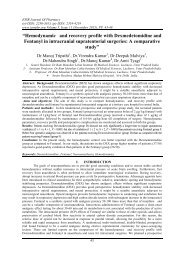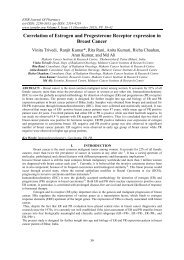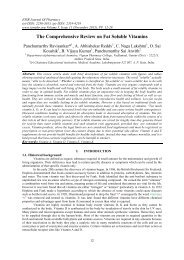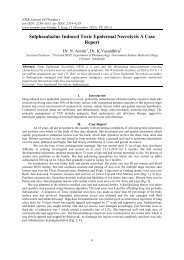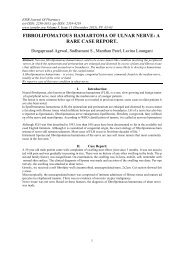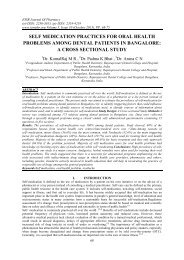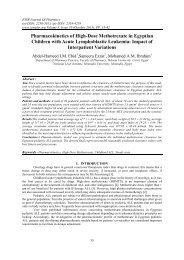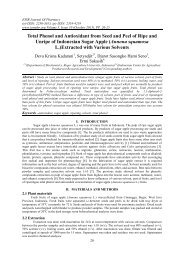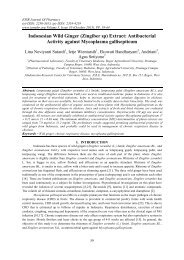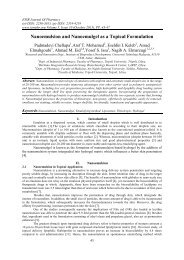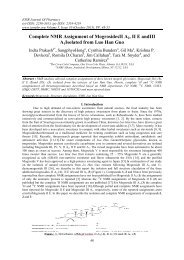Study of Bioactive components in Decalepis hamiltonii invitro
Create successful ePaper yourself
Turn your PDF publications into a flip-book with our unique Google optimized e-Paper software.
63<br />
<strong>Study</strong> <strong>of</strong> <strong>Bioactive</strong> <strong>components</strong>…<br />
A variety <strong>of</strong> analytical tools is available to study prote<strong>in</strong> conformation. Of these methods, Fourier<br />
Transform Infrared Spectrometry (FTIR) has proven to be the most versatile [8]. It allows analysis <strong>of</strong> prote<strong>in</strong><br />
conformation <strong>in</strong> a diverse range <strong>of</strong> environments, e.g. upon b<strong>in</strong>d<strong>in</strong>g to membranes [9], at the air-water <strong>in</strong>terface<br />
[10], <strong>in</strong> organic solvents [11], or <strong>in</strong> the dehydrated state [12 -13]. The versatility <strong>of</strong> FTIR is based on the long<br />
wavelength <strong>of</strong> the radiation, which m<strong>in</strong>imizes scatter<strong>in</strong>g problems. Fourier transform <strong>in</strong>frared (FTIR) analysis<br />
was carried out to determ<strong>in</strong>e the <strong>in</strong>volvement <strong>of</strong> the type <strong>of</strong> functional groups [14].<br />
II. MATERIALS AND METHODS<br />
2.1 Preparation <strong>of</strong> explants<br />
Healthy plants <strong>of</strong> <strong>Decalepis</strong> <strong>hamiltonii</strong> Wight & Arn, were collected from Shivamogga, Karnataka<br />
state, India, subjected for micro propagation. Axillary buds <strong>of</strong> D. <strong>hamiltonii</strong> were washed under runn<strong>in</strong>g tap<br />
water to remove soil and other superficial contam<strong>in</strong>ation. S<strong>in</strong>gle bud explants (1 cm each) with upper portion<br />
were washed with Tween 20 (5% v/v) for 5 m<strong>in</strong> followed by thorough wash<strong>in</strong>g under runn<strong>in</strong>g tap water for 15<br />
m<strong>in</strong>. The explants were surface sterilized with 0.15% (w/v) mercuric chloride for 3 to 5 m<strong>in</strong> and later r<strong>in</strong>sed 4 or<br />
5 times with sterile distilled water [15].<br />
For this experiment shoot <strong>in</strong>duction stage MS basal medium with 3% <strong>of</strong> sucrose (w/v) was used.Explants<br />
were cultured <strong>in</strong> conical flasks (150 ml) covered with non-absorbent cotton plugs and the medium was<br />
subsequently autoclaved at a temperature <strong>of</strong> 121°C for 15 m<strong>in</strong>. The growth regulators, N 6 -benzyladen<strong>in</strong>e (BA; 1.1<br />
µM), gibberellic acid (GA 3 ; 5.8 µM) were added to MS basal medium and then phlorogluc<strong>in</strong>ol (PG; 80-1600 µM)<br />
tried <strong>in</strong>dividually and <strong>in</strong> comb<strong>in</strong>ation to obta<strong>in</strong> the most suitable level for proliferation <strong>of</strong> shoots <strong>in</strong> established<br />
explants [16].<br />
The cultures were kept at an <strong>in</strong>cubation temperature <strong>of</strong> 25 0 ± 2 0 C and light for 16 hr/day us<strong>in</strong>g fluorescent<br />
lights for 30 days. S<strong>in</strong>gle shoot explant (2 cm) with a node or nodal explants was kept <strong>in</strong> flask. Rooted plantlets<br />
after 45days growth were removed from the medium, freed <strong>of</strong> agar by wash<strong>in</strong>g <strong>in</strong> runn<strong>in</strong>g tap water and planted<br />
<strong>in</strong> sand: compost mixture (1:2) for harden<strong>in</strong>g for 30 days at about 80% RH under polyethylene hoods <strong>in</strong> the<br />
greenhouse and then transplanted <strong>in</strong> the field [17].<br />
The Tuber parts collected and they were surface sterilized first with 200 ml <strong>of</strong> 70% (v/v) alcohol for 5<br />
sec, by wash<strong>in</strong>g with sterile water thrice, and then blotted with sterilized blott<strong>in</strong>g paper. About 100 g each plant<br />
part were grounded <strong>in</strong>to paste <strong>in</strong> mixer and used for extraction <strong>in</strong> dichloromethane. Dichloromethane was<br />
utilized for extraction s<strong>in</strong>ce it is permitted for extraction <strong>of</strong> oleores<strong>in</strong>s and other food constituents. Extracts were<br />
pooled and were separated with water <strong>in</strong> separat<strong>in</strong>g funnel. This extract was dried <strong>in</strong> vacuum and resuspended <strong>in</strong><br />
ethanol (1 mg mL-1) and used for further experiment at desired concentration. The dichloromethane extract<br />
dissolved <strong>in</strong> ethanol was subjected to antioxidant activity / Antiradical activity test [18].<br />
2.2 Antiradical activity test<br />
The antiradical activity <strong>of</strong> the extracts was estimated as 0.3mM solution <strong>of</strong> DPPH radical solution <strong>in</strong><br />
ethanol 90% was prepared and then 1 ml <strong>of</strong> this solution was mixed with 2.5 ml <strong>of</strong> different concentrations <strong>of</strong><br />
each extract (sample). After 30 m<strong>in</strong> <strong>in</strong>cubation <strong>in</strong> dark and at room temperature, absorbance (A) was measured<br />
at 518 nm <strong>in</strong> a SHIMADZU Multispect-1501 spectrophotometer [19].<br />
The percentage <strong>of</strong> the radical scaveng<strong>in</strong>g activity (RSA) was calculated by the follow<strong>in</strong>g equation:<br />
[A control – (A sample – A blank)]<br />
RSA% = -------------------------------------------- × 100<br />
A control<br />
Ethanol 90% (1 ml) plus each sample solution (2.5 ml) was used as a blank. DPPH solution (1 ml) plus<br />
ethanol 90% (2.5 ml) was used as a negative control. Rut<strong>in</strong> Solution (at the concentrations <strong>of</strong> 100, 50, 25, 10, 5,<br />
2.5 μg ml-1) was used as a positive control. The IC50 value for each sample, def<strong>in</strong>ed as the concentration <strong>of</strong> the<br />
test sample lead<strong>in</strong>g to 50% reduction <strong>of</strong> the <strong>in</strong>itial DPPH concentration, was calculated from the non l<strong>in</strong>ear<br />
regression curve <strong>of</strong> Log concentration <strong>of</strong> the test extract (μg ml-1) aga<strong>in</strong>st the mean percentage <strong>of</strong> the radical<br />
scaveng<strong>in</strong>g activity.<br />
2.3 Total Polyphenol content<br />
The total phenol content was determ<strong>in</strong>ed [20], with Aliquots (250 μl) <strong>of</strong> each extracts were taken <strong>in</strong> test<br />
tubes and made up to the volume <strong>of</strong> 1 ml with distilled water. Then 0.5ml <strong>of</strong> Fol<strong>in</strong>-Ciocalteu phenol reagent (1:1<br />
with water) and 2.5ml <strong>of</strong> sodium carbonate solution (20%) were added sequentially <strong>in</strong> each tube. Rapidly after<br />
vortex<strong>in</strong>g the reaction mixture, the test tubes were placed <strong>in</strong> dark for 40 m<strong>in</strong>utes and the absorbance was




